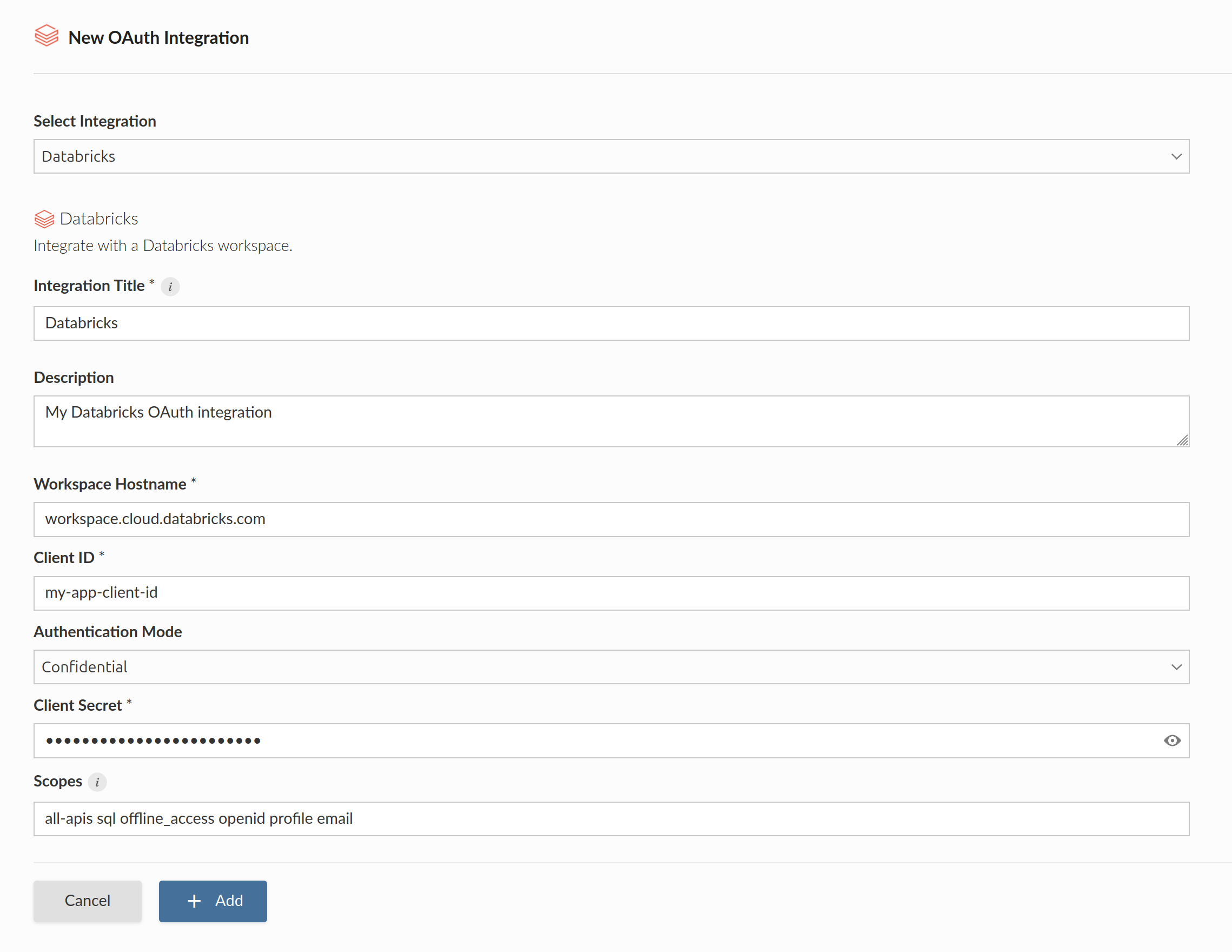Databricks
Configuring a Databricks OAuth integration in Posit Connect involves two main steps, each performed by different administrators.
- Step 1: A Databricks administrator creates an OAuth application in Databricks.
- Step 2: A Posit Connect administrator creates an OAuth integration within Connect.
This guide walks through both steps of this process, providing the necessary information for each administrator role.
Step 1: Databricks administrator
Viewer integration
To support the creation of a Viewer OAuth integration in Posit Connect, the Databricks administrator registers a new OAuth Application in the Databricks account.
There is no Databricks UI that supports this operation, so the following commands require use of the Databricks CLI. The following are pre-requisites:
- Install the Databricks CLI.
- Set up authentication between the Databricks CLI and the Databricks account.
The Databricks administrator decides whether this OAuth application requires client authentication.
For Confidential OAuth applications, provide the --confidential flag when creating the custom-app-integration in the next step. Public OAuth applications should omit the --confidential flag.
If unsure whether to create a Confidential or Public OAuth application, choose Confidential.
Use the Databricks CLI to register a custom OAuth app integration in the Databricks account. This example creates a Confidential OAuth application. Replace connect.example.org with the address of the Connect server.
For OAuth application administrators who prefer to use the same OAuth application for both Posit Connect and Posit Workbench, simply register the Workbench redirect URL (https://workbench.example.org/oauth_redirect_callback) in addition to the Connect redirect URL.
Terminal
databricks account custom-app-integration create \
--confidential \
--json '{
"name": "posit-connect",
"redirect_urls": ["https://connect.example.org/__oauth__/integrations/callback"],
"scopes": ["all-apis", "sql", "offline_access", "openid", "profile", "email"]
}'The redirect is where Databricks sends the user’s OAuth credentials at the end of the OAuth handshake. This allows Connect to obtain a temporary access token and refresh token from Databricks, which is used to access protected resources on behalf of the user.
The output should be similar to the following:
{"integration_id":"<integration-id>","client_id":"<client-id>","client_secret":"<client-secret>"}The integration_id refers to the custom OAuth application in the Databricks account. Do not confuse this ID with the oauth-integration-guid in Connect.
The Databricks administrator makes note of the client_id and client_secret from the registered OAuth application and shares this information with the Connect administrator.
To delete or disable this integration in the future, use the Databricks CLI as follows:
Terminal
databricks account custom-app-integration delete <integration-id>Service account integration
To support the creation of a Service Account OAuth integration in Connect, the Databricks administrator creates a Service Principal in their Databricks account. The Databricks administrator generates an OAuth Secret for the service principal, and makes note of the generated OAuth Client ID and Secret. This information is shared with the Connect administrator.
Transfer information to Connect administrator
The Databricks administrator shares the following information with the Posit Connect administrator:
| Field | Description |
|---|---|
workspace_hostname |
The hostname of your Databricks environment. |
client_id |
The unique identifier of the OAuth application. |
client_secret |
The secret string provided in the output from OAuth application creation. Not required for Public Viewer integrations. |
scopes |
Permissions supported by the OAuth application. Only include the scopes required by Connect. |
Step 2: Posit Connect administrator
Create OAuth integration in Posit Connect
Using the information from the Databricks administrator, the Posit Connect administrator creates an integration through the dashboard’s System > Integrations settings. Once the OAuth integration has been created in Connect, it is available for use by all publishers.
Alternatively, the example below shows how to create a Confidential Databricks OAuth integration using curl and the Connect Server API.
Replace connect.example.org with the address of the Connect server. Replace cust-success.cloud.databricks.com with the Databricks workspace hostname.
Terminal
curl -H "Authorization: Key ${CONNECT_API_KEY}" \
-XPOST https://connect.example.org/__api__/v1/oauth/integrations \
--data '{
"template": "databricks",
"description": "A helpful description for publishers to use when choosing an OAuth integration for their content.",
"name": "Databricks OAuth integration",
"config": {
"auth_mode": "Confidential",
"auth_type": "Viewer",
"workspace_host": "cust-success.cloud.databricks.com",
"client_id": "<databricks-client-id>",
"client_secret": "<databricks-client-secret>"
}
}'
# 200 OK
# {"guid": "<oauth-integration-guid>", ... }